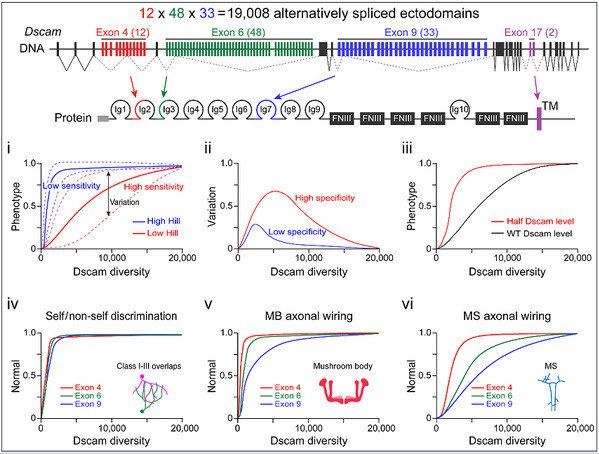
Title: A systematic CRISPR screen reveals redundant and specific roles for Dscam1 isoform diversity in neuronal wiring
Haiyang Dong, Xi Yang, Lili Wu, Shixin Zhang, Jian Zhang, Pengjuan Guo, Yiwen Du, Changkun Pan, Ying Fu, Lei Li, Jilong Shi, Yanda Zhu, Hongru Ma, Lina Bian, Bingbing Xu, Guo Li, Feng Shi, Jianhua Huang, Haihuai He, Yongfeng Jin
Abstract
Drosophila melanogaster Down syndrome cell adhesion molecule 1 (Dscam1) encodes 19,008 diverse ectodomain isoforms via the alternative splicing of exon 4, 6, and 9 clusters. However, whether individual isoforms or exon clusters have specific significance is unclear. Here, using phenotype–diversity correlation analysis, we reveal the redundant and specific roles of Dscam1 diversity in neuronal wiring. A series of deletion mutations were performed from the endogenous locus harboring exon 4, 6, or 9 clusters, reducing to 396 to 18,612 potential ectodomain isoforms. Of the 3 types of neurons assessed, dendrite self/non-self discrimination required a minimum number of isoforms (approximately 2,000), independent of exon clusters or isoforms. In contrast, normal axon patterning in the mushroom body and mechanosensory neurons requires many more isoforms that tend to associate with specific exon clusters or isoforms. We conclude that the role of the Dscam1 diversity in dendrite self/non-self discrimination is nonspecifically mediated by its isoform diversity. In contrast, a separate role requires variable domain- or isoform-related functions and is essential for other neurodevelopmental contexts, such as axonal growth and branching. Our findings shed new light on a general principle for the role of Dscam1 diversity in neuronal wiring.
Link: https://doi.org/10.1371/journal.pbio.3002197






